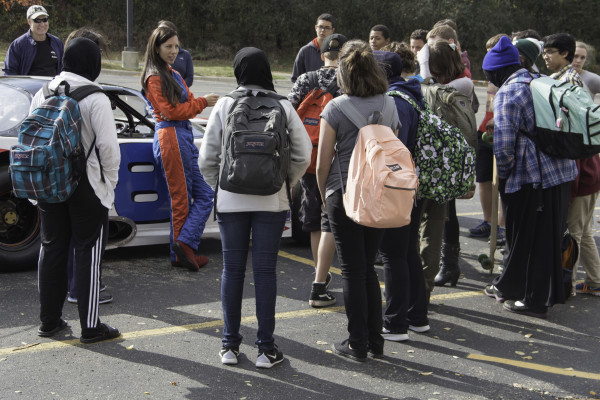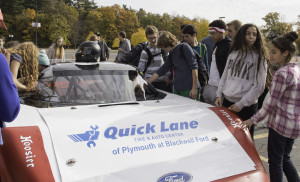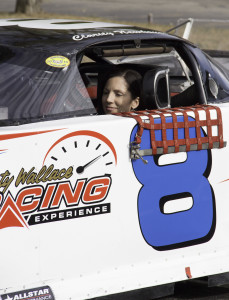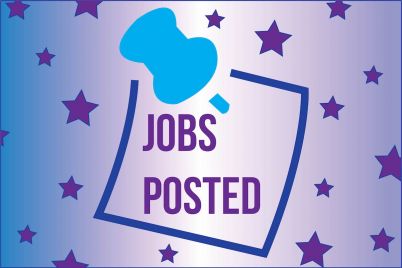
Clarity Newhouse, of Farmington, informs students of the opportunities the field of engineering can create. GRAY BANCROFT | WASHTENAW VOICE
Racecar driver Clarity Newhouse visits WCC in hopes of teaching students about STEM classes via her mobile science lab
BY TAYLOR MABELITINI
Contributor
A gathering of wide-eyed students hung on Clarity Newhouse’s every word as she spoke. This may, however, have something to do with the race car parked behind her. Newhouse, her crew and the car in question were presenting what they call their Mobile Science Lab. A program began this year in which students from a variety of Michigan schools have the opportunity to learn practically about physics, combustion and much of the other science behind racing, as well as career opportunities in the STEM fields: science, technology, engineering and math.
Elise Thompson and Drew Zemper, both Washtenaw Technical Middle College science teachers, contacted Newhouse, and it was their classes of ninth grade students who were in the Gunder Myran parking lot to witness the deafening roar of the race car’s engine before getting to see how it operated under the hood.

A racecar pulls up and a multitude of students gather around to get a closer look. GRAY BANCROFT | WASHTENAW VOICE
Thompson and Zemper both teach one class, co-teach a third together, and are also Better Accounting of Student Efforts counselors for their WTMC students, working to guide them towards a career pathway and an eventual degree at Washtenaw Community College.
“The kids got to come out and observe the car, and see what some of the differences were between this car and the cars they drive every day. The main point of today was really to have the kids come out and see the kind of careers there are in engineering and technology, and to kind of see what’s out there for them,” Thompson said.
During the presentation, Newhouse allowed students to examine the car and encouraged them to ask questions, explaining what made this car so different both scientifically and physically – everything from the V8 engine to the windshield to the mechanisms on the steering wheel – that allowed it to race.
“It was pretty awesome. We got to learn a lot about how the racing industry makes their cars, and the logic of why they make their cars that way,” said 14-year-old WTMC student Colin Wilson.
Newhouse wasn’t all racing wheels and spark plugs, however. She also tried empowering students by saying they could be in any career they really wanted to be, even outside of STEM. As one who started following her passion to race barely more than a year ago, Newhouse – being both a woman and nearly 40 years old, two things that made her feel even more so challenged to prove herself – tries to do her best to let students know that it’s “never too early to late to start.”
“For me I wanted to hopefully show other people what they could do, and break down some gender stereotypes, and give some hands-on science as well. For me, science doesn’t really come to life until it applies in real life. It’s cool in a book, you can kind of learn about it, but I feel like when you can actually see how the things you are learning about apply in real life, that’s really cool,” she said.

Pulling up to the students in her race car. Clarity Newhouse, of Farmington, enjoys putting some of her work background into racing cars. Gray Bancroft | Washtenaw Voice
Newhouse began as a rookie this past racing season during the summer at her home track in Flat Rock, MI, and gives her Mobile Science Lab presentations during the school year. She placed 14th out of 42 racers, and gave all of the winnings from each of her races to the Women Marines Association. It’s this passion Newhouse has for supporting strong women that stood out to 13-year old Maggie Lerolland-Wagner:
“It’s really interesting, just because it’s really rare to see racecar drivers that are female, so I think that’s a really big part of it. I think the way she brings herself up is really cool because you can tell she’s really into feminist movements.”
It was the zeal Newhouse had for telling students they could be whatever they wanted to be that encouraged WTMC student Christian Davis.
“I think it was really cool because I want to go into engineering and manufacturing here at Washtenaw, and I kind of want to go into in as a career, so it inspired me to go for it more.”
Newhouse only had a few words for what she wished students would take away from the Mobile Science Lab.
“I hope that it expands their mind to more possibilities, and to have new ideas about what they might be capable of,” Newhouse said.

